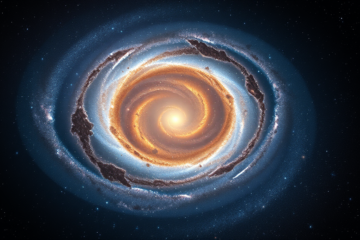Psyche Transmits Data in Optical Communications
The recent Psyche probe mission highlights advances in Optical Communications, demonstrating the ability to transmit large volumes of data over long distances.
In this article, we will explore how Psyche, after completing successful tests of Deep Space Optical Communications (DSOC) technology, sent a message to Earth from 350 million kilometers away, transmitting 13.6 terabytes of information, including ultra-high-definition video.
We will also analyze the impact of this innovation on space communication and its implications for future missions, such as those destined for Mars and beyond.
Sending the Message 350 Million Kilometers
The Psyche probe has achieved an impressive milestone by transmitting messages 350 million kilometers from Earth., using advanced Deep Space Optical Communications technology known as DSOC.
This achievement not only marked the successful completion of the tests of the DSOC, but also opened up new possibilities for space communications.
Using 65 laser signals, the probe managed to send 13.6 terabytes of data, including an ultra-high-definition video, with a transmission rate of 267 megabits per second.
This revolutionary achievement demonstrates the potential power of this technology to transform future interplanetary missions, such as those destined for Mars.
Upon completion of the tests, Psyche will continue its journey toward the asteroid belt, converting its communications back to radio-based.
However, the success of the DSOC paints a future in which high-definition video and large volumes of scientific data can be transmitted between planets with unprecedented efficiency, highlighting the importance of telecommunications innovations for space exploration.
Such advancement offers a glimpse of what is to come in the realm of interplanetary communication.
Deep Space Optical Communications Technology
Deep Space Optical Communications (DSOC) technology represents a significant advancement in the way information is transmitted between space probes and Earth.
Using laser signals, DSOC managed to transmit 13.6 terabytes of data, reaching an impressive rate of 267 megabits per second during tests carried out by the Psyche probe.
Using 65 laser signals, this technology demonstrates revolutionary potential for future space missions, including the possibility of sending high-definition videos and large volumes of scientific data.
DSOC Fundamentals
DSOC, a remarkable NASA innovation, uses laser transmission for deep space communication, outperforming traditional radio antennas in terms of speed and efficiency.
Through an advanced transceiver, laser beams encode data into pulses of light, sending digital information with incredible precision.
This method not only increases data capacity but also improves the clarity and reliability of communication.
With DSOC, future missions will be able to transmit massive amounts of scientific data quickly, as highlighted by NASA.
This represents a significant milestone for space exploration.
Psyche Test Results
The probe Psyche reached a significant milestone by completing technology testing Deep Space Optical Communications (DSOC).
She successfully transmitted 13.6 terabytes of data to Earth, including ultra-high-definition video, through 65 laser signals.
This technology provided faster and higher capacity communication, reaching a rate of 267 megabits per second over long distances.
This progress is promising for future missions to Mars, enabling the agile transmission of high-quality videos and large volumes of scientific data.
This success opens up new possibilities for advanced space exploration.
Total Data Number of Signs Peak Speed 13.6 TB 65 267 Mbps
DSOC Impact on Future Missions
The success of the Psyche probe demonstrates a crucial advance in the technology of Deep Space Optical Communications (DSOC).
This innovation allows video transmissions in high definition, essential for the progress of missions to Mars and beyond.
Optical communication technology has the power to transform future space exploration because of its superior data transmission capacity.
This advancement facilitates the sending of large amounts of scientific data, which are crucial to the success of interplanetary missions.
Notably, faster data transfer rates, which can reach up to 267 megabits per second, mean that researchers on Earth will be able to receive real-time information from Mars, aiding in analysis and more immediate response to challenges.
- Higher speed: Faster video and data transmission.
- Improved data capacity: Support for large volumes of scientific information.
- Access to high-definition videos: Detailed visuals for study and sharing with the public.
The time savings and accuracy provided by this technology will revolutionize future missions, exponentially increasing our understanding of the Universe.
Continuation of the Journey to the Asteroid Belt
After completing Deep Space Optical Communications tests, the Psyche probe begins a new phase of its mission, adopting radio communications.
This transition is crucial to ensure continued contact during the long journey to the asteroid belt.
Radio communications, while less fast than the innovative laser technology previously tested, remain reliable and modulated over long distances.
The switch to radio ensures that the control team on the ground consistently receives vital data about the mission's status.
It is important to ensure this connectivity given the vastness of the space and the complexity of navigation to the destination.
During the journey of approximately 3.5 billion kilometers, as reported by Psyche Mission, radio communication will allow trajectory updates and systems monitoring.
This uninterrupted contact not only supports the current mission, but also provides essential insights that could benefit future space exploration, such as eventual human trips to Mars and beyond.
This continuity of communication maintains the safety and effectiveness so necessary in a large-scale mission like this.
The success of Optical Communications in the Psyche probe project will open up new possibilities, not only for space exploration, but also for the transmission of scientific data in high definition on future interplanetary missions.
The future of communication in space looks promising.



0 Comments